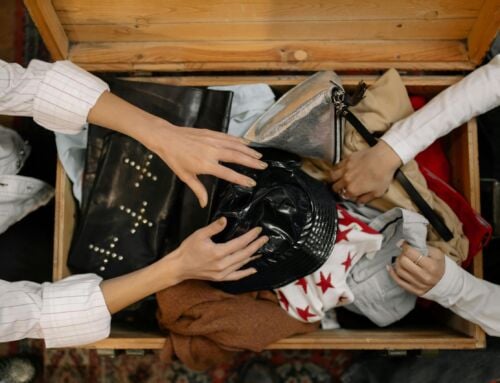La différence entre haute couture, couture, créateurs et prêt-à-porter : l’innovation dans le secteur du luxe
L’histoire de la mode est indissociable de celle de la société. Chaque vêtement, chaque style reflète une époque, une culture, et souvent une vision du monde. Pourtant, les termes haute couture, couture, créateurs et prêt-à-porter ne sont pas de simples synonymes. Ils symbolisent des étapes clés dans l’évolution de la mode et de ses dynamiques.
Dans cet article, nous plongeons dans l’histoire de ces concepts, explorons leurs spécificités et mettons en lumière leur rôle dans un secteur qui se réinvente aujourd’hui à travers l’innovation durable.
Un voyage dans le temps : la naissance de la haute couture
La haute couture telle que nous la connaissons aujourd’hui a vu le jour au XIXᵉ siècle grâce à l’influence du couturier anglais Charles Frederick Worth. Installé à Paris, il révolutionne la mode en introduisant le concept de créateur de mode. Contrairement aux tailleurs anonymes de l’époque, Worth signait ses créations, transformant le vêtement en œuvre d’art et l’artisan en artiste.
La haute couture a évolué pour devenir l’emblème du luxe, associée à des noms comme Coco Chanel, qui libéra la femme de corsets étouffants dans les années 1920, ou Christian Dior, dont la silhouette « New Look » de 1947 redéfinit la féminité après la guerre.
À savoir : Depuis 1945, l’appellation « haute couture » est strictement réglementée afin de préserver son prestige et son exclusivité. Symbole ultime de créativité et de savoir-faire artisanal, la haute couture répond à des critères exigeants :
Fabrication artisanale : chaque pièce est confectionnée à la main, souvent sur mesure.
Exclusivité : ces créations sont destinées à une clientèle élitiste.
Prix élevés : en raison des matériaux rares et du temps nécessaire à leur réalisation.
Couture et créateurs : une réponse aux besoins changeants
Si la haute couture est réservée à une élite, la couture s’est rapidement développée pour offrir des options plus accessibles à une clientèle bourgeoise au XIXᵉ siècle. Elle conserve un aspect artisanal tout en répondant à une demande croissante pour des vêtements de qualité mais moins exclusifs.
À partir du XXᵉ siècle, des créateurs indépendants ont commencé à défier les normes. Dans les années 1960, par exemple, des designers comme Yves Saint Laurent introduisirent le concept de prêt-à-porter de luxe, rendant la mode haut de gamme plus accessible sans sacrifier la créativité. Aujourd’hui, des créateurs contemporains comme Marine Serre et Jacquemus poursuivent cet héritage en intégrant des pratiques durables et des designs innovants.
Point clé historique : L’émergence des créateurs a permis à la mode de se démocratiser, tout en maintenant des normes de qualité et de créativité élevées.
Le prêt-à-porter : une révolution industrielle
Le prêt-à-porter, ou ready-to-wear, est un produit direct de la Révolution industrielle au XIXᵉ siècle. Les avancées technologiques ont permis la production de vêtements en série, rendant la mode abordable pour une plus grande partie de la population.
Dans les années 1960, le prêt-à-porter a connu un essor fulgurant grâce à des créateurs comme Pierre Cardin, qui a su marier innovation et production de masse. Aujourd’hui, ce segment de l’industrie est dominé par des géants comme Zara ou H&M, mais il évolue pour intégrer des pratiques plus responsables face aux défis environnementaux.
Points marquants :
1) Avant l’industrialisation, les vêtements étaient faits sur mesure ou cousus à la maison.
2) Le prêt-à-porter a démocratisé l’accès à la mode tout en posant les bases de la fast fashion, un modèle remis en question pour son impact écologique.
L’innovation durable : l’avenir de la mode de luxe
Si l’histoire de la mode est marquée par l’innovation, le défi actuel est celui de la durabilité. Les grandes maisons de luxe, autrefois associées à l’opulence sans limites, adoptent aujourd’hui des pratiques plus respectueuses de l’environnement.
Les initiatives récentes les plus marquantes :
- Louis Vuitton : Réduction des déchets dans la production
En 2021, Louis Vuitton a lancé des lignes en édition limitée utilisant des chutes de tissu de collections précédentes, une initiative appelée « Upcycling Signal ». Cette pratique vise à minimiser les déchets tout en valorisant les matériaux existants. - Chloé : Certification B Corp
En 2021, la maison Chloé est devenue la première grande marque de luxe à obtenir la certification B Corp, témoignant de son engagement à équilibrer profit et impact positif sur la planète et les communautés. - Prada : Nylon recyclé
Prada a introduit en 2019 une collection appelée « Re-Nylon », fabriquée à partir de nylon recyclé provenant de filets de pêche récupérés dans les océans et de déchets industriels. L’objectif est de convertir tout son nylon classique en nylon recyclé d’ici 2025. - Balenciaga : Défilé neutre en carbone
En 2022, Balenciaga a organisé un défilé totalement neutre en carbone. Cela inclut l’utilisation de matériaux recyclés pour les décors, une logistique optimisée et des compensations carbone pour tous les déplacements liés à l’événement. - Moncler : Projets climatiques globaux
La marque Moncler s’est engagée à devenir carboneutre d’ici 2030. Elle travaille sur des initiatives comme l’amélioration de l’efficacité énergétique dans ses usines et le lancement de projets communautaires de reboisement. - LVMH : Alliance avec l’UNESCO pour la biodiversité
En 2020, le groupe LVMH a annoncé un partenariat avec l’UNESCO visant à protéger les écosystèmes naturels essentiels à la production de matières premières comme le coton, le cuir et la laine. - Kering : Mesure de l’impact environnemental
Le groupe Kering (propriétaire de Gucci, Saint Laurent, etc.) a développé l’Environmental Profit & Loss Account (EP&L), un outil pour mesurer l’impact environnemental de ses activités à chaque étape de la chaîne de production. - Alexander McQueen : Don de matériaux aux écoles de mode
La marque Alexander McQueen s’est associée à des écoles de mode pour leur fournir des surplus de tissus et matériaux haut de gamme, encourageant ainsi l’innovation et réduisant les déchets. - Burberry : Neutralité carbone dans ses magasins
Burberry a atteint la neutralité carbone dans toutes ses boutiques en 2022, grâce à l’utilisation d’énergie 100 % renouvelable et à la compensation des émissions résiduelles. - Stella McCartney : Le cuir fabriqué en laboratoire
Pionnière de la mode durable, Stella McCartney a collaboré avec des entreprises de biotechnologie pour développer des alternatives au cuir animal, comme le cuir fabriqué en laboratoire à partir de cellules animales.
Comment recycler ses vêtements facilement ?
Voici des solutions pratiques pour participer à cette transformation :
- Dons solidaires : Partagez vos vêtements inutilisés avec des associations comme Emmaüs ou La Croix-Rouge.
- Customisation créative : Transformez une ancienne pièce pour lui donner une nouvelle vie.
- Recycler avec des marques : Profitez des services de collecte offerts par des marques comme H&M ou Uniqlo.
Ces initiatives, inspirées par une prise de conscience croissante, rapprochent la mode d’un modèle plus circulaire et responsable.
Pour approfondir ce sujet, n’hésitez pas à consulter également notre article intitulé : Mode et durabilité : donner une seconde vie à nos vêtements
Pourquoi ces distinctions comptent-elles aujourd’hui ?
Comprendre l’histoire et les différences entre haute couture, couture, créateurs et prêt-à-porter aide à apprécier leur impact sur la société et notre rôle en tant que consommateurs.
Respect de l’artisanat : En choisissant des pièces de qualité, vous soutenez des traditions qui risquent de disparaître face à la production de masse.
Conscience écologique : Les choix éco responsables favorisent la préservation de la planète.
Soutien aux créateurs indépendants : Encourager l’innovation locale est essentiel pour maintenir une industrie dynamique.
Le consommateur moderne est plus qu’un simple acheteur : il est un acteur de changement. Pour aller plus loin dans cette démarche, nous vous invitons à découvrir nos programmes de Bachelors et Mastères, qui forment les futurs leaders du monde de la mode et du luxe. Nos cursus permettent de visualiser l’avenir de l’industrie tout en développant une conscience professionnelle respectueuse de l’artisanat, de l’écologie et de l’innovation




